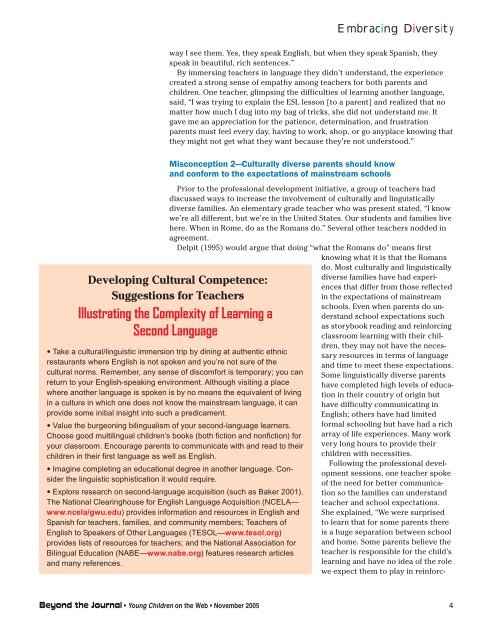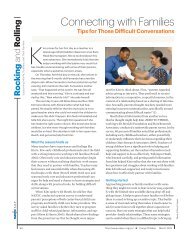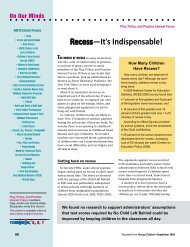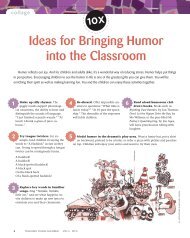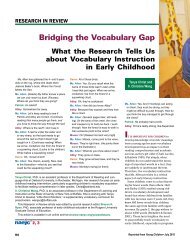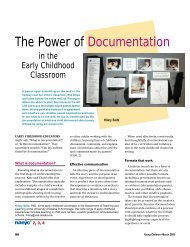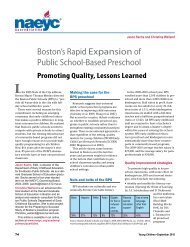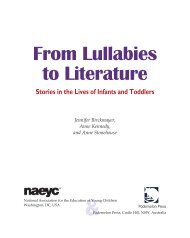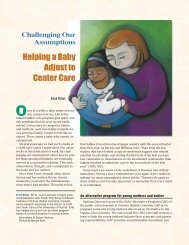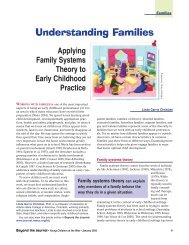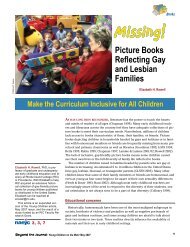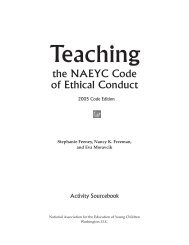Reflections from Teachers of Culturally Diverse Children - National ...
Reflections from Teachers of Culturally Diverse Children - National ...
Reflections from Teachers of Culturally Diverse Children - National ...
You also want an ePaper? Increase the reach of your titles
YUMPU automatically turns print PDFs into web optimized ePapers that Google loves.
Embracing Diversity<br />
way I see them. Yes, they speak English, but when they speak Spanish, they<br />
speak in beautiful, rich sentences.”<br />
By immersing teachers in language they didn’t understand, the experience<br />
created a strong sense <strong>of</strong> empathy among teachers for both parents and<br />
children. One teacher, glimpsing the difficulties <strong>of</strong> learning another language,<br />
said, “I was trying to explain the ESL lesson [to a parent] and realized that no<br />
matter how much I dug into my bag <strong>of</strong> tricks, she did not understand me. It<br />
gave me an appreciation for the patience, determination, and frustration<br />
parents must feel every day, having to work, shop, or go anyplace knowing that<br />
they might not get what they want because they’re not understood.”<br />
Misconception 2—<strong>Culturally</strong> diverse parents should know<br />
and conform to the expectations <strong>of</strong> mainstream schools<br />
Prior to the pr<strong>of</strong>essional development initiative, a group <strong>of</strong> teachers had<br />
discussed ways to increase the involvement <strong>of</strong> culturally and linguistically<br />
diverse families. An elementary grade teacher who was present stated, “I know<br />
we’re all different, but we’re in the United States. Our students and families live<br />
here. When in Rome, do as the Romans do.” Several other teachers nodded in<br />
agreement.<br />
Delpit (1995) would argue that doing “what the Romans do” means first<br />
knowing what it is that the Romans<br />
do. Most culturally and linguistically<br />
Developing Cultural Competence:<br />
Suggestions for <strong>Teachers</strong><br />
Illustrating the Complexity <strong>of</strong> Learning a<br />
Second Language<br />
Take a cultural/linguistic immersion trip by dining at authentic ethnic<br />
restaurants where English is not spoken and you’re not sure <strong>of</strong> the<br />
cultural norms. Remember, any sense <strong>of</strong> discomfort is temporary; you can<br />
return to your English-speaking environment. Although visiting a place<br />
where another language is spoken is by no means the equivalent <strong>of</strong> living<br />
in a culture in which one does not know the mainstream language, it can<br />
provide some initial insight into such a predicament.<br />
Value the burgeoning bilingualism <strong>of</strong> your second-language learners.<br />
Choose good multilingual children’s books (both fiction and nonfiction) for<br />
your classroom. Encourage parents to communicate with and read to their<br />
children in their first language as well as English.<br />
Imagine completing an educational degree in another language. Consider<br />
the linguistic sophistication it would require.<br />
Explore research on second-language acquisition (such as Baker 2001).<br />
The <strong>National</strong> Clearinghouse for English Language Acquisition (NCELA—<br />
www.ncela/gwu.edu) provides information and resources in English and<br />
Spanish for teachers, families, and community members; <strong>Teachers</strong> <strong>of</strong><br />
English to Speakers <strong>of</strong> Other Languages (TESOL—www.tesol.org)<br />
provides lists <strong>of</strong> resources for teachers; and the <strong>National</strong> Association for<br />
Bilingual Education (NABE—www.nabe.org) features research articles<br />
and many references.<br />
diverse families have had experiences<br />
that differ <strong>from</strong> those reflected<br />
in the expectations <strong>of</strong> mainstream<br />
schools. Even when parents do understand<br />
school expectations such<br />
as storybook reading and reinforcing<br />
classroom learning with their children,<br />
they may not have the necessary<br />
resources in terms <strong>of</strong> language<br />
and time to meet these expectations.<br />
Some linguistically diverse parents<br />
have completed high levels <strong>of</strong> education<br />
in their country <strong>of</strong> origin but<br />
have difficulty communicating in<br />
English; others have had limited<br />
formal schooling but have had a rich<br />
array <strong>of</strong> life experiences. Many work<br />
very long hours to provide their<br />
children with necessities.<br />
Following the pr<strong>of</strong>essional development<br />
sessions, one teacher spoke<br />
<strong>of</strong> the need for better communication<br />
so the families can understand<br />
teacher and school expectations.<br />
She explained, “We were surprised<br />
to learn that for some parents there<br />
is a huge separation between school<br />
and home. Some parents believe the<br />
teacher is responsible for the child’s<br />
learning and have no idea <strong>of</strong> the role<br />
we expect them to play in reinforc-<br />
Beyond the Journal Young <strong>Children</strong> on the Web November 2005 4


